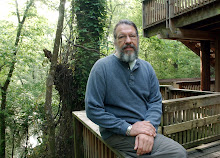American Robin munching yaupon holly berries
(photo by Steve Pagans)
It really is a no-brainer. I love food. I love birds. I love wild plants. So why shouldn't I love birds who love food-producing wild plants? It's become a lifelong fascination.
Back in the 1980s when I began working at the Acadiana Park Nature Station (Lafayette, LA), a book in the facility's library caught my attention: American Wildlife Plants – A Guide to Wildlife Food Habits (Martin, Zim, & Nelson, Dover Publications, 1951). A wonderful read, to be sure. But the thing was dated, man. Nineteen-fifty-one, you know? So I initiated a literature search for more recent stuff. The news wasn't good. Worldwide, I found no more than a handful of papers, only two of which dealt with birds and wild fruits in the southern U.S. In fact, the majority of those references dealt with bird gut sample results conducted back in the early 1900s by U.S. Department of Agriculture biologists – back when birds were viewed as either human food sources or noxious crop pests.
Yellow-breasted Chat on Service-berry Tree (Amelanchier arborea)
(photo by Beth Erwin...or maybe Rector Hobgood)
When I whined about this to LSU ornithologist Van Remsen, his reply was quick and to-the-point: “Why don't you conduct your own bird/wild fruit survey?” So that's what happened. Besides Remsen and myself, I managed to recruit a couple of dozen folks from around Louisiana who knew their birds and their wild fruits. For nearly five years (1994 through 1998), we recorded every instance of a bird eating a wild fruit that we observed, totaling 1,040 bird/fruit interactions in all, involving a total of 67 bird species and 50 plant species. I think we learned a lot about Louisiana birds and the wild berry species upon which they rely. I know I did.
during our survey, we observed 13 different bird species using
rough-leaf dogwood fruits, including several species of vireos & flycatchers...
since the survery, 3 additional observations involving Hermit Thrush,
Yellow-rumped Warbler, and Baltimore Oriole (above) have been reported.
Today, some observers still send me bird/fruit observations, the most recent of which came from Shreveport birder Terry Davis, who sent me this fine photo taken by Mark Priddy of a female Baltimore Oriole consuming rough-leaf dogwood (Cornus drummondii) berries.
Red-bellied Woodpecker lusting after black cherries
(photo by Russ Norwood http://www.perceptivist.com/)
So what did we find out from our 1994-98 survey? Well one of the first things that struck me was the fact that all woodpeckers love fruit. All woodpecker species like all sorts of berries. One of my best memories from the survey involved a family of four Pileated Woodpeckers – mom, dad, and two youngsters. There was a nice black cherry tree right in the middle of the Acadiana Park Campground. The campground was empty, and the woodpecker parents had escorted their young to the cherry tree in order “show them what's good.” As the woodpeckers ate, the youngsters began to holler – with delight, I guess – which attracted a motely crew of American crows. The crows descended around the cherry tree, themselves hollering and side-swiping the woodpecker family. Expectedly, the youngsters were freaked, but the parents nonchalantly held their ground, completely ignoring the crows. The youngsters followed suit.
poison ivy....late at nite, when you sleepin'.....
note tiny berries top/center
Cedar Waxwing scarfing down evil Chinese privet berries
(photo by Matt Conn)
In a related side-story, we also noted that the very best wild fruit plants – those which routinely attracted the most birds and the highest diversity of different species – tended to be plants that humans consider to be trashy. At the very top of the list, for example, is hackberry, a tree whose presence few property-owners will tolerate. As mentioned, poison ivy ranked high, as well as other hated/disliked species such as Virginia creeper, red mulberry, elderberry, and Chinese privet. Don't even get me started on Chinese tallow fruits. That's a subject for another post....








No comments:
Post a Comment